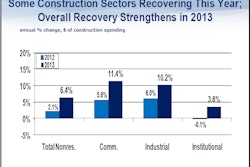 To ensure a pavement mix using recycled asphalt shingles (RAS) isn’t too soft, all mixes in Illinois must be tested with the Hamburg Wheel test. The test uses a 158-pound steel wheel, which is run under water. The specimen is put in a heated water bath and run back and forth 20,000 times
To ensure a pavement mix using recycled asphalt shingles (RAS) isn’t too soft, all mixes in Illinois must be tested with the Hamburg Wheel test. The test uses a 158-pound steel wheel, which is run under water. The specimen is put in a heated water bath and run back and forth 20,000 timesRecycled asphalt shingles, or RAS, are gaining popularity in recycled asphalt pavement (RAP) mixes as agencies, contractors go green to save green.
When Illinois decided to begin including RAS in the state’s recycled asphalt pavement RAP mixes back in 2010, it was already a late player in the RAS business. “Other states such as Wisconsin, Missouri, and Minnesota had already started to use the shingles,” Jay Behnke, owner and president of S.T.A.T.E. Testing, tells Better Roads. “The City of Chicago and the Illinois Tollway both had the desire to use the shingles, but no one was grinding them so you couldn’t get them.”
Once the first shingles in Illinois were obtained from Madison, Wis., to use for the Illinois Tollway and the Chicago Department of Transportation (CDOT), concern was raised about asbestos in RAS. Although production of shingles with asbestos stopped around 1972, IDOT noted that tearing off three layers of a roof presents the potential for asphalt shingles to contain asbestos.“IDOT also had a problem with bridge decks back in the 1980s,” Behnke explains. “They [asbestos] were used in the waterproof membrane system used to seal the deck.”
But the concern went beyond rooftops and bridge decks.IDOT and the U.S. Environmental Protection Agency (EPA) were also very concerned about incorporating asbestos testing when roads needed to be milled out. “Working with the [Illinois] Tollway, EPA and IDOT, they all came up with a rigorous testing protocol “that tested pretty much every truck that is coming in,” Behnke says. “The good news is that to date, IDOT, the Illinois Tollway Authority and the contractors have never found one hit of asbestos in any of the shingles in Illinois in the more than 10,000 samples tested. But the protocol is still in place.”
Even with this additional effort, Behnke says, use of RAS is still saving money. “It’s been determined that about $30 per ton is being saved,” he says. “The Tollway has seen savings in its stone-matrix asphalt (SMA).”
 Michigan Avenue in Chicago, known as “The Magnificent Mile,” was repaved using recycled asphalt shingles (RAS) in the pavement mix. The project is known as “The Magnificent Green Mile”
Michigan Avenue in Chicago, known as “The Magnificent Mile,” was repaved using recycled asphalt shingles (RAS) in the pavement mix. The project is known as “The Magnificent Green Mile”From a contractor standpoint, Behnke says he thinks RAS is so successful in Illinois is because of the specification developed that the shingles must be ground very fine. “When you take tear off roof shingles and are done grinding and screening them, 100 percent must pass a 3/8-inch,” Behnke says. “I believe this puts Illinois on the cutting edge. Many other states must just be 1 inch or 5/8 inch, although some have gone to 1/2 inch. No one else is requiring 3/8 inch, but because it’s ground finder, the asphalt concrete (AC) is more readily used in a mix. If it is in big chunks in the AC, the bigger piece stays in those pieces and it’s not available to the hot mix itself. They don’t see the cost savings.”
Traditionally in Illinois, the base AC was PG64 -22, meaning the AC won’t crack unless it gets below -22 degrees C (-12 degrees F). “The concern with RAS is the AC when it’s made with shingles,” Behnke says. “A shingle AC is closer to a PG90 -10. It is better for the top end. The top number ensures the mix won’t rut. In the case of PG64, it won’t deform or rut as long as the temperature doesn’t get above 64 degrees C. But RAS is PG100 -10. It’s not as good on the lower end for thermal cracking.”
Instead of using PG64 -22, the state is now using a softer grade AC – a PG58 -28, or in some cases, PG46 -34, a very soft-grade liquid,” Behnke says. “We are allowing stiffness of the AC from the RAA and DRAP to make the top end higher, but we are building in resistance on the lower end for thermal cracking by using softer grade liquid on the virgin side of the aggregate.”
However, to ensure the mix isn’t too soft, all mixes in Illinois must be tested with the Hamburg Wheel test. Texas, as well as some other states, also uses this test. The Hamburg Wheel test is a 158-pound steel wheel, which is run under water. The specimen is put in a heated water bath and run back and forth 20,000 times. “If the mix isn’t stable, it just ruts up extremely quick,” Behnke explains. “Our requirement is 20,000 cycles, and [the mix] can’t exceed 1/2-inch rut depth. If it meets these requirements, we deem it acceptable.”
This was the first year of mandating the test in Illinois,Behnke notes, adding, “Let’s face it. Everyone wants to be green and save money. We are being very green and pushing the envelope, but we need to make sure the performance is there.”
|
The variables of using RAS in RAP Many variables – including the grade of hot-mix asphalt produced, the cost for virgin liquid asphalt and alternative aggregates, landfill tipping fees, and the capital cost of equipment, as well as acquisition, processing, and handling expenses–come into play when estimating possible cost savings of using recycled asphalt shingles (RAS) in recycled asphalt pavement (RAP), according to ShingleRecycling.org. “Savings are relative, and largely relate to the price of liquid asphalt cement (AC),” according to a National Asphalt Pavement Association (NAPA) report, based on a series of presentations at NAPA’s seminar Reclaimed/Reprocessed Materials in Hot-Mix Asphalt. Written by C. Jackie Williams, the article, Interest Mounts in Recycled Roofing Shingles: As Savings Accrue to Producers, Landfill Space is Saved, indicates that if the price of liquid AC is high, shingles offer a greater potential for savings, according to the online resource. |
(For “Using RAS: Recycled asphalt shingles are an acquired taste,” which includes interviews with John Christensen, technical marketing manager for MWV Specialty Chemicals, a division of MeadWestvaco Corp (MWV) and Steve Jackson, P.E., quality control manager of Missouri-based NB West, be sure to check out the July 2012 edition of Better Roads in print or at www.betterroads.com/digital.)













